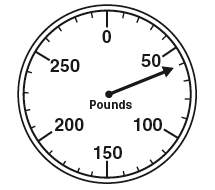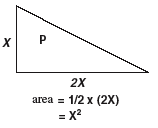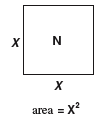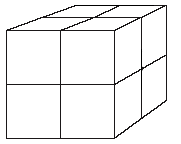Appendix B: Mathematical Complexity Items Scoring Guide
Low Complexity
How many fourths make a whole?Answer: ___________________
Source: 1996 NAEP (grade 4) Percent correct: 50
Scoring Guide
| Scoring Rubric |
|---|
| 1 - Correct 4, 4 fourths, etc. |
| 0 - Incorrect Any incorrect response |
Which of the following is NOT a property of every rectangle?
-
A. The opposite sides are equal in length.
B. The opposite sides are parallel.
C. All angles are equal in measure.
*D. All sides are equal in length.
E. The diagonals are equal in length.
What is 2/3 of 15 marbles?
-
*A. 10 marbles
B. 9 marbles
C. 8 marbles
D. 5 marbles
(Students did not have access to a calculator.)
+6 + –12 =
-
*A. –6
B. +6
C. –18
D. +18
N stands for the number of stamps John had. He gave 12 stamps to his Which expression tells how many stamps John has now?
-
A. N + 12
*B. N – 12
C. 12 – N
D. 12 x N
How many hours are equal to 150 minutes?
-
A. 11/2
B. 21/4
C. 21/3
*D. 21/2
E. 25/6
What is the weight shown on the scale?
Moderate Complexity
(Grade 8 version)
Who was correct? _______________________________
Use words or pictures (or both) to explain why.
An adequate explanation with or without Bob. Parts of P overlap N, and part sticks out. The sticking out part is equal to the left out part of N.
OR
Two P’s match two N’s therefore they have the same area. (Therefore, one N has the same area as one P.)
OR
Areas are equal because height of P is the same as the height of N, and the base of P is twice the base of N.
OR
Either of these two figures alone are acceptable.
In this figure, how many small cubes were put together to form the large cube?
From any vertex of a 5-sided polygon, 2 diagonals can be drawn.
From any vertex of a 6-sided polygon, 3 diagonals can be drawn.
From any vertex of a 7-sided polygon, 4 diagonals can be drawn.
How many diagonals can be drawn from any vertex of a 20-sided polygon?
Scoring Guide
Scoring Guide
Tracy, with correct answer given.
OR
No name stated but reason given is correct.
Examples of correct reasons:
Tracy with no reason.
OR
Any response that states Pat is correct.
OR
No name stated and reason given is incorrect.
High Complexity
Marcy has to determine the number of dots in the 20th step, but she does not want to draw
all 20 pictures and then count the dots. Explain or show how she could do this and give the
answer that Marcy should get for the number of dots.
Source: 1992 NAEP (grade 8) Percent correct: 6
Scoring Guide
Explanation should include one of the following ideas with no false statements.
Jaime knows the following facts about points A, B, and C.
In the space provided, use a diagram to explain your answer.
Scoring Guide
Correct response. Both correct diagrams are given
OR
If correct diagram is clearly indicated either by circling and/or the incorrect ones are crossed out.
Any incorrect reason OR if there is no indication of which diagram is correct (by circling or crossing out incorrect one).
NOTE: Points need to be indicated by some mark, such as a dot or tick mark. A response in which points are indicated by letters only is an automatic incorrect.
In Mr. Bell’s classes, the students voted for their favorite shape for a symbol.
Here are the results.
Class 1 Class 2 Class 3 Shape N 9 14 11 Shape P 1 9 17 Shape Q 22 7 2
Using the information in the chart, Mr. Bell must select one of the shapes to be the symbol.
Which one should he select and why?
Explain:
Scoring Guide
N, because more students chose it.
OR
N, because it was first choice in one class and second choice in the other classes.
"Majority" is acceptable (taken to mean most). If student says most classes, do not accept.
Shape Q chosen, with an explanation that refers to a number of votes
OR
Shape N chosen, but explanation not given or is inadequate with incorrect computation.
OR
Any other incorrect response.

A. 6 pounds
Source: 1992 NAEP (grade 4) Percent correct: 44
B. 7 pounds
C. 51 pounds
*D. 60 pounds


Bob, Carmen, and Tyler were comparing the areas of N and P. Bob said that N and P have
the same area. Carmen said that the area of N is larger. Tyler said that the area of P is larger.
Source: 1996 NAEP (grade 8) Percent correct: 27
Scoring Rubric
1 - Correct
May say "neither" or "both."






1 - Correct
Correct response (Click here to see).
0 - Incorrect
Bob was correct, but explanation not given or inadequate Any response that answers Carmen or Tyler to "Who was correct?" or omits the name and gives no satisfactory explanation.

A. 7
Source: 1996 NAEP (grade 4) Percent correct: 33
*B. 8
C. 12
D. 24
From any vertex of a 4-sided polygon, 1 diagonal can be drawn.
Answer: ___________________________
Source: 1996 NAEP (grade 8) Percent correct: 54
Scoring Rubric
1 - Correct
17
Number of diagonals is always 3 less than the number of sides.
0 - Incorrect
Any incorrect response.
Tracy said, "I can multiply 6 by another number and get an answer that is smaller than 6."
Pat said, "No, you can’t. Multiplying 6 by another number always makes the answer 6 or
larger."
Source: 1992 NAEP (grades 8 and 12)
Who is correct? Give a reason for your answer.
Percent correct: 49 (grade 8); 63 (grade 12)
Scoring Rubric
1 - Correct
0 - Incorrect

Scoring Rubric
4 - Extended
Correct answer. (Must state 420; must tie step 20 back to beginning of pattern in some specific form of generalization.)
3- Satisfactory
Correct explanation of pattern but does not include or omits the correct number of dots.
2- Partial
A partial (incomplete) correct explanation, i.e., does not tie together.
1 - Minimal
Any attempt to generalize OR to draw all 20 pictures in the pattern (with a clear understanding of the pattern).
0 - Incorrect
The work is completely incorrect, irrelevant, or off.
Jaime concluded that point C is always between points A and B.
Is Jaime's conclusion correct?
Source: 1996 NAEP (grade 8) Percent correct: 23
![]() Yes
Yes ![]() No
No
The explanation must include either one of the following diagrams:
Diagram should include or illustrate the idea that B is halfway between A and C.

Scoring Rubric
1 - Correct
0- Incorrect

The shape Mr. Bell should select: _________________
Source: 1996 NAEP (grades 4 and 8)
Percent correct: 31 (grade 4); 58 (grade 8)
Scoring Rubric
1 - Correct
0- Incorrect
Previous
Contents
Next
Mathematics Framework for the 2005 National Assessment of Educational Progress